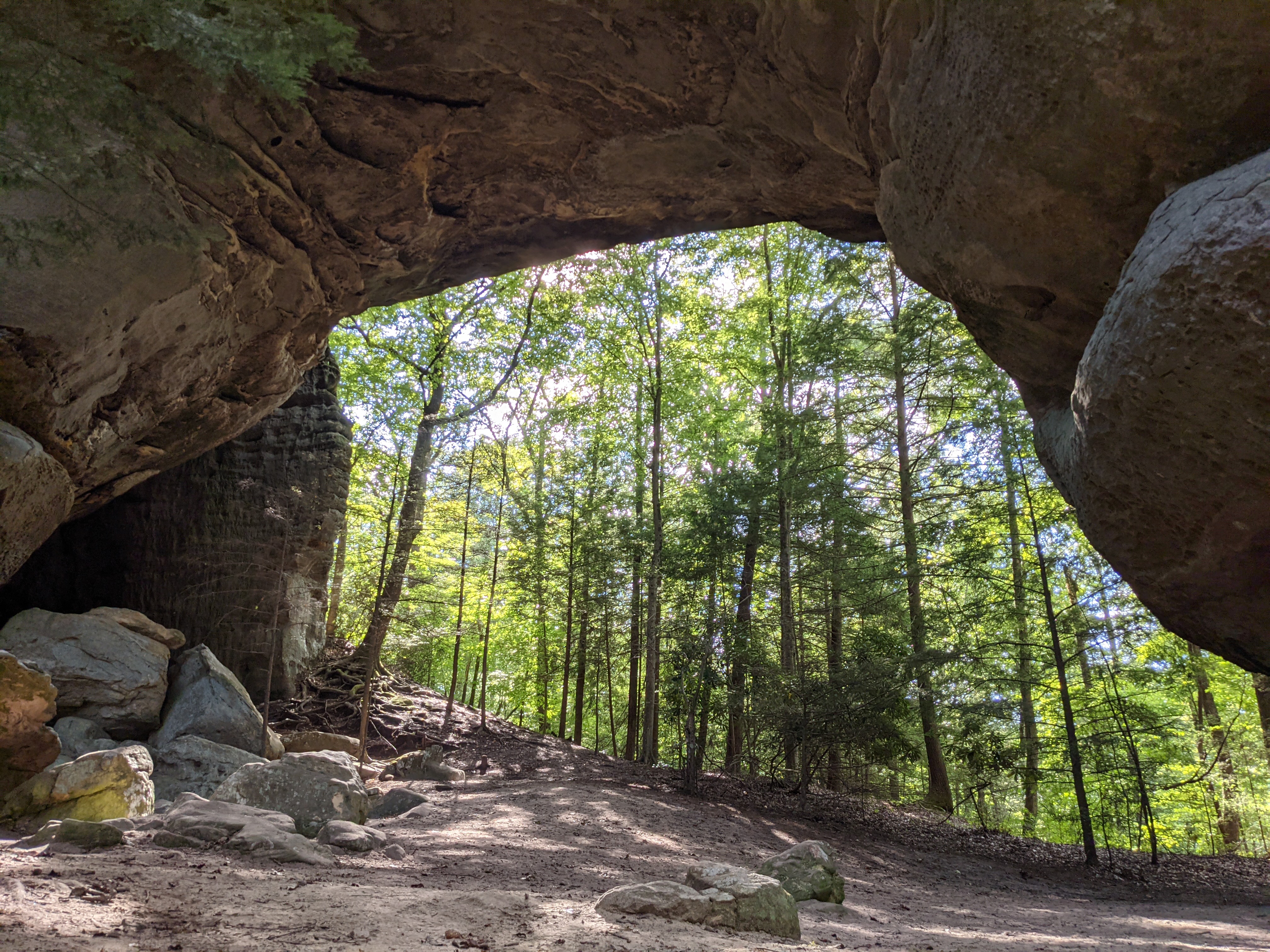Chapter 7 Introduction to the Three Regions
7.1 The Tennessee Valley
7.2 The Cumberland Plateau
I taught at a high school (and went to college) in North Carolina and the drive from North Carolina to my family in Michigan usually took me through the highway that winds down from around Asheville, past Candler, and through the heart of the outhern Appalachian mountains. The Appalachian Trail crosses the highway - I-40 - and at different points along the drive one is between a few and five or so miles from the Smokies. The drive is often a bit wild; rock slides very regularly close the highway, sometimes for weeks.
At the same time, when moving to Knoxville, I am not sure I could have said what or where the Cumberland Plateau is. This sounds absolutely banal, but I believe the key to initially understanding the area is that it’s a plateau–and that makes it distinct from the mountains. Also, it’s different from Michigan.
Here’s a picture from this past weekend at Big South Fork:

twin arches in big south fork
Ostensibly, one of the Twin Arches is the largest ock arch in the Eastern United States and one of the largest in the world. I think being a part of the Cumberland Plateau - being close to the Southern Appalachian and Smoky moutains - they slip beneath peoples’ radar. There seems to be a near-constant conservation effort, with more land being purchased to be public. Taking the acreage of Big South Fork National (part of the National Park system; ~125,000) and the Cumberland Trail (~35,000), Fall Creek Falls (25,000), Frozen Head (~25,000), South Cumberland (~25,000), and Pickett (20,000) State Parks alone (there are other public lands), this area is around half of the size of the Smokies (~500,000 acres).
This is all to say, I have an interest in spending more time in this area and to try to understand it a bit better.
7.3 The Smokies
The Smokies can be a bit hard to get one’s head around at first.
It can be hard to get one’s head around the Smokies for several reasons:
- Their size: more than 800 square miles
- Their location: split roughly between Tennessee and North Carolina, there are many ways to access the park, and there isn’t a primary or best way to do so
- Their variation in altitude: Abrams Creek—the trailhead nearest to Knoxville—is roughly 850 feet above sea level, whereas Clingman’s Dome is roughly 6,650 feet above sea level
- Their biodiversity: it may be the most biodiverse National Park
- Their human history: thousands of people of European ancestry lived in what is now the National Park up until as recently as 1934 (when the park was established); before people of European ancestry lived there, thousands of people of Cherokee ancestry lived there; these histories remain alive and present within the park
I think these reasons are important in general and in a bit of an abstract sense, but they also have a more personal angle: The Smokies are hard to experience for each of these and other reasons, too. They appear and are different in different seasons. They are very different when experienced when walking than when driving in a car. They are different when it’s rainy and when it’s not. And, they are different alone, with family, with friends, and with a child.
7.3.1 A bit on my understanding of the Smokies
When my wife and I first decided to move to Knoxville, I began trying to understand the Smokies, and since then I’ve read a lot of books and spent a lot of time there. I don’t think I can adequately summarize the Smokies, but I can begin to convey my understanding.
The Smokies are a timeless place, at once welcoming and severe. When I drive to the Smokies, I feel like I’m entering into a special place. That special feeling is amplified by the good memories I’ve had there—with my family and friends and on my own.
I value living by the Smokies a lot. This is a function of a lot of things coming together: stopping refereeing soccer, something I’d done for around 12 years up to that point, soon after we moved to Knoxville, the pandemic, which prevented many other activities from happening, and a live for doing things outdoors that motivated me to study biology and enter teaching to begin.
I’ll describe just one trip to try to work to summarize my understanding of the Smokies.
In May, 2020, my wife and little one and I hiked the beginning of the Bote Mountain and West Prong trails to the location of Backcountry site #18. It was one of our first times heading out after the pandemic began, and it was a moderately difficult hike - around three miles, but with nearly 1,000 feet of climbing. When we arrived at the site—where two creeks meet and are crossed by a log bridge—there were butterflies everywhere, which the little was overjoyed about.
This was one trip, and it was probably one that we planned on a whim, picking the trail based on what was within an hour’s drive. That’s what made it special; there wasn’t anything particularly distinctive about that trail, hike, or day (except for the butterflies, which were pretty neat), and both this absence of distinctiveness coupled with a sense of someting special has nearly always been the case for the time I’ve spent in the Smokies.
So, as a bit of a thesis, it’s hard to understand the Smokies: they’re too large, varied, and rich. But, it is possible to experience the Smokies, and doing so doesn’t require making it to Mt. LeConte or Abrams Falls or Clingman’s Dome (though each of those are pretty great). One can perhaps have just as positive of an experience as at those (sometimes busy) sites off trails or at picnic areas in the Big Creek, Cosby, and Tremont areas.